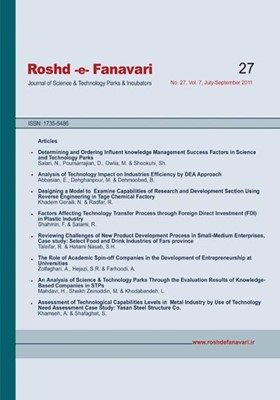-
-
List of Articles
-
Open Access Article
1 - Determining and Ordering Influent Knowledge Management Success Factors in Science and Technology Parks
Nasibeh Salary Daroush Pouserajian Mohammad Saleh Oliua shahram shokohi -
Open Access Article
2 - Analysis of Effect of Technology in Industries Efficiency by DEA Approach
Ezatollah Abbasiyan Mohammad reza Dehghanpour Babak Deo mobed -
Open Access Article
3 - Designing a Model to examin Research and Development section´s capabilities with emphasis on reversed engineering in Tage chemical Factory
Neda Khadem Garayeli Reza Radfar -
Open Access Article
4 - Factors Affecting Technology Transfer Process through Foreign Direct Investment (FDI) in Plastic Industry
Farhad Shah miri Seyed reza Salami -
Open Access Article
5 - Reviewing Challenges of New Product Development Process in Small-Medium Enterprises Case study:Select Food and Drink Industries of Fars province
Reza Talei Far Seyed Hosein Hatami nasab -
Open Access Article
6 - The Rule of Academic Spin off Companies in the Development of Entrepreneurship at the Universities
Atefeh Zolfaghari Seyed reza Hejazi Arta Farmodi -
Open Access Article
7 - An analysis of Science & Technology Parks Through the Evaluation Results of K-Based Companies in STPs
Hamid Mahdavi Mahmod Sheykh zeynoddin Leyla Khodabandeh -
Open Access Article
8 - Assessment of Technological Capabilities levels in metal industry by use of technology need assessment
Abbas Khamseh Sabktakin Shafaghat
-
The rights to this website are owned by the Raimag Press Management System.
Copyright © 2017-2025







